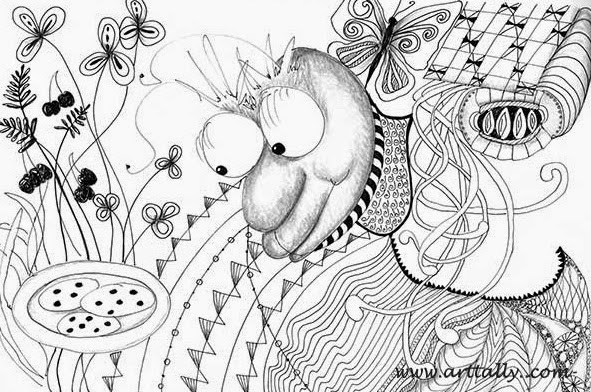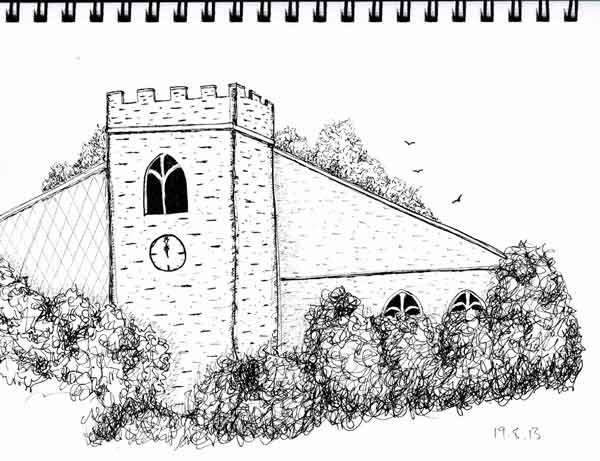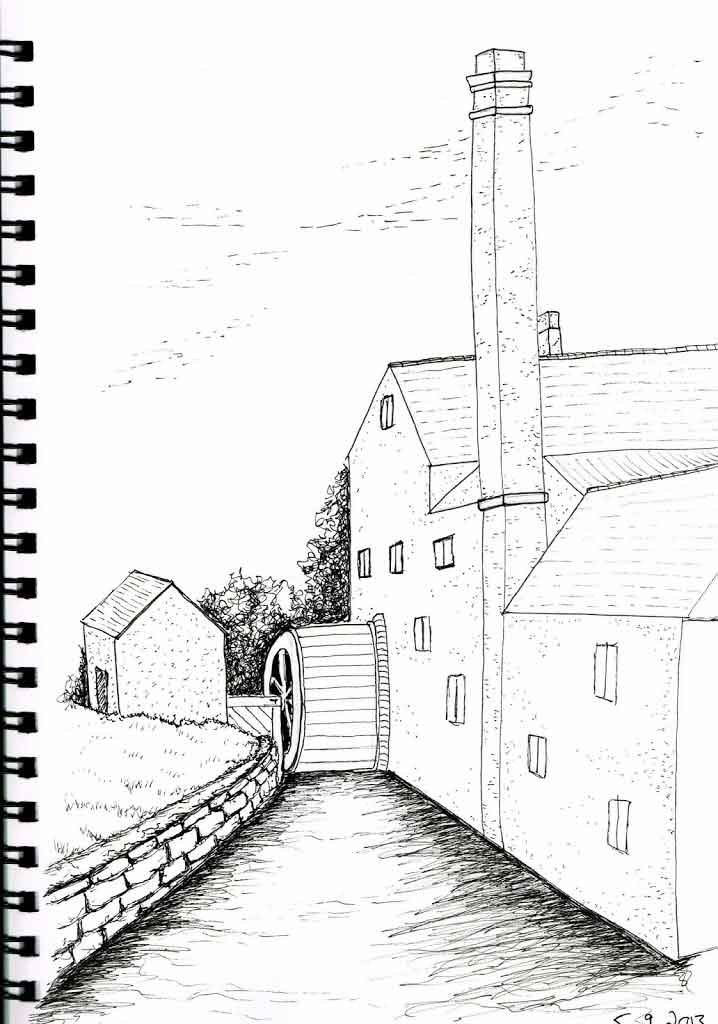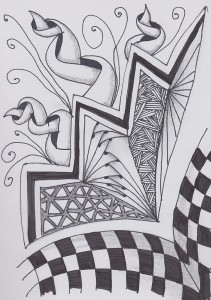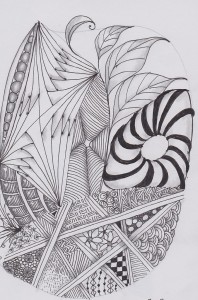Is letting go of control actually the best way to be more in control?
| Pen doodle that started with a random squiggle |
I have been to a lot of little girls' seventh birthday parties recently, and every one seems to include a mandatory, very loud and heartfelt group rendition (or six) of 'Let it Go', from the movie Frozen. I have taken it as a message from the universe as art seems to be trying to teach me the same thing. Let go of control. Not so very long ago I was a working mother of baby twins in the middle of my PhD. My coping strategy back then was total control freakery (it's a word, let's just go with it...) That worked, quite well even... up to a point. My idea of control was to be totally organised, everything scheduled and prepared in advance, meals, play-dates, laundry, research seminars, work tasks, everything. At one point I remember trying to plan for my planning sessions! Obsessing over planning and preparation means you are living in the future. It becomes harder to remain present, and you can start missing out on any of the joys of now. And if your belief is that you must be prepared for every eventuality, what you are really telling yourself is that you are incapable of handling life on the fly. It turns out that the only thing you can be certain of is that uncertainty is unavoidable. Being organised is great, it's important. But when you find yourself viewing unforeseen circumstances as a planning and preparation failure, you know you have gone too far. The thing is, the very skills you use to plan and prepare are the skills you will draw on when something unexpected turns up. We all possess the creative skills to make the best of such a situation, as it arises, without prior planning. But we have to have enough faith in ourselves to allow that to happen. Learning to draw and paint is teaching me as much about life as it is about art. Maybe more. Cheapest therapy ever. I have been drawn to doodling (ok almost addicted), and I think it is because I have been reflecting on this idea of going with the flow, letting go of how something is supposed to be and just working with what turns up.
I started the doodle on this page with a random squiggle in the middle of the page. That seemed to be a funny face, so a face it became. I felt like making some patterns so I did. Apparently I was hungry because some cookies and cherries turned up. It is a surprising relief to just 'be'. I am learning that you can make art without a preconceived notion of how it should look when it is finished. And you can live your life well, without a perfect plan.
Is it possible to be disciplined without a deadline?
 |
| Tiny journal page from my latest online class 'Draw Your Awesome Life' |
I have been feeling a bit overwhelmed by being a bit behind on my online classes. On the one hand, there is really no such thing as being behind. The classes typically have long access, 6 months, a year or 'forever' access. So actually you can complete them in your own time. On the other hand, there is a lot to be said for the sense of satisfaction that comes from completing something promptly. A bit of structure is important I think. Does one actually need a deadline of some sort in order to be disciplined enough to complete the task?
I remember in high school I had a maths teacher who said she would happily correct our homework if and when we chose to hand it in, but that was up to us. I could so have got a better mark for maths. I blame her. I don't want my art classes to end up like high school maths, left to last because other things had more urgent deadlines. So with the weight of those uncompleted art assignments added to my maths homework (which I have obviously still not done), I sighed and started web browsing.
Before I knew it I had... signed up to another class! I know, but it seemed logical at the time. And this class is different. (Not really). Well, a little. It is completed in a tiny watercolour journal. Hurrah, I had one of those knocking about already. It is even a Moleskine and I have had no idea what to do with it since I bought it several months ago.
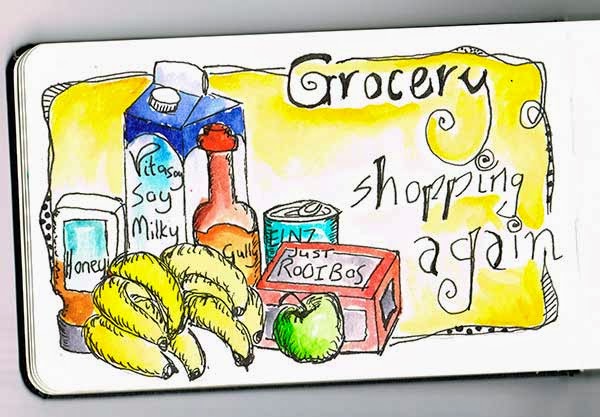 |
| Another tiny journal page created in 'Draw Your Awesome Life' |
This class is called Draw your Awesome Life, by Joanne Sharpe. Each lesson video is brief, maybe even 5 minutes or so, and since you are working in a tiny journal, the page can possibly be completed in 10 minutes. Even if you sit down with a cup of tea you will probably be only half an hour from the start of the lesson video to the completed page. That's not to say that I don't love the long detailed lesson videos I do in other courses. Of course, they are fantastic too. But these little bite-sized lessons offer very achievable, happy journal pages, for de-stressing. There is a time and place for all of these things, don't you think?
Observation: fundamental drawing principle and exercise in mindfulness
Disclosure: This post may contain affiliate links. That means if you buy something we may possibly get a very small commission at no extra cost to you, and we thank you.
Cathedral pen sketch following Mark Linley's instructions on buildings in
One of the most important parts of learning to draw is the power to observe. Actually, it is becoming apparent that the best drawings come from spending more time looking at your subject than at looking at your drawing in progress. So important is this skill that some art teachers make you draw without looking at your paper at all. This is fun, obviously, and you end up with some kooky whimsical drawings, but the point is that the better one's power of observation, the better the drawing, regardless of subject.
And that is important I think. In his jolly good book, 'How to draw anything', Mark Linley advises that one should learn to draw everything well and then specialise. Very liberating that would be too... Imagine being able to draw whatever crazy thing pops into your head...
Water mill pen sketch following Mark Linley's instructions on buildings in
However, the thing I probably underestimated is that not only is this good drawing practice but it is also an exercise in mindfulness. In order to carefully study something, to notice the way the light falls, to observe the shapes as they actually appear and not as you think they are, you need to be truly 'present'. Being present in the moment allows you to notice the joyful minutiae of life. If you have ever taken a walk with a three year old, you will know how very many minutes can be happily wiled away engrossed in the examination of every leaf, stick and bug on the pathway. I am finding that drawing is doing much the same thing for me - it can be completely absorbing.
Being present in the moment and delighting in the simple things is what the experts tell us is a pathway to happiness. Mindfulness has been shown to be helpful for stress, anxiety and depression. I'm all for learning to meditate and taking mindfulness training. But, I couldn't be happier at the realisation that it need not be too complicated - that, in fact, a few moments of stillness and calm would seem to be a fairly effortless by-product of the joyful practice of drawing.
Learning to exhale with Zentangle
I've spent so much of my life in the world of business and economics, and there is a part of me that loves that. It can be exciting and dynamic. But much like many other parts of life (juggling work, parenting, domestic chores, fitness, etc.) it seems to me to be all 'inhale'. 'Exhaling' seems increasingly tricky. I have been learning to meditate for many years, and think that it is likely to be something I continue to work on for the rest of my life. I don't know about you, but I find as a busy, active person, that sitting still and trying to just 'be' can be frustrating and sometimes impossible. It can be about as soothing and effective as the well meant words, 'don't panic', offered to an hysterical woman.
I have discovered the delightful art of Zentangle, and this seems to be an easily applied salve to the troubled mind. There is no pressure of colour choice (usually black pen, Sakura Pigma Micron, for preference) and no possibility of making a mistake (the art is non-representational). Beautiful patterns emerge from the repetition of simple lines and strokes. Each tangle is supposed to be small (3 1/2 inch square), making it quick to complete. I must admit I enjoy it so much that I have done tangles of all sorts of sizes depending on available time and mood!
Zentangle artists seem to be among the most generous, I think. A quick Google search will turn up an abundance of reference material for a beginner, and with just a few simple pointers, it is easy to get started. The first stop would have to be www.zentangle.com to see the creators of Zentangle (Rick and Maria Thomas) and hear their explanations of the ethos of Zentangle. The site also offers beginner's kits, and other resources, as well as a list of Certified Zentangle Trainers in your area.
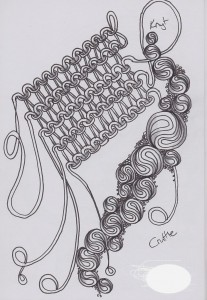 |
| 'Knyt' and 'Cruffle' from the instructions on tanglepatterns.com |
I think my favourite Zentangle resource would have to be Linda Farmer's site www.tanglepatterns.com where there is a comprehensive library of step by step instructions for different patterns, generously shared by Tanglers everywhere. I really enjoy learning a new pattern and seeing how a potentially complex design is broken down to its simple parts.
Whether it is to de-stress, to warm up and get into the art 'zone' or for no reason at all, I think Zentangle really is for everyone.
There is nothing more delightful than a cartoon, is there?
I am drawing because it is fun. And I can't think of anything more fun than a cartoon. Cartooning is something of a long held ambition for me. I am a perpetual student, and have this habit of acquiring books on random subjects that usually don't see immediate use.
 |
| My drawing of 'Screaming Mimi' from Jack Keeley's 'Cartooning 1' |
In my stash I have found two favourites, both Walter Foster books, 'Cartooning 1', by Jack Keeley and 'Cartooning', by Hal Tollison. The former includes a section on 'Crazy Characters'. This really speaks to me. No matter what sort of day you have been having, 'Screaming Mimi' can only make you smile, don't you think?
She was delightful to draw, but the delight is somewhat tempered by the fact that I am copying her. There is something uncomfortable about that for me. I remind myself that I am a beginner, and one has to start somewhere. I found some lofty support for that notion, too:
"If one knows how to copy, one knows how to do" Leonardo Da Vinci
And here is another drawing copied from the same section of this book. I love the minimal lines and careful use of positive and negative areas. I would like to say this is something of a self portrait, but I fear 'Screaming Mimi' might be closer to the mark in that regard...

